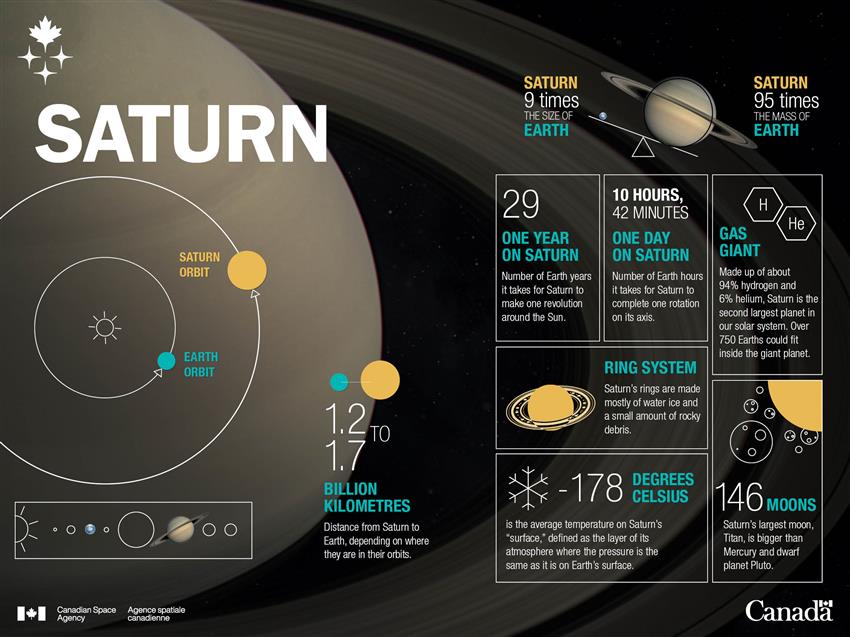Saturn
About Saturn
| Type | Gas giant |
|---|---|
| Size (diameter) | 116,464 km, or about 9 Earths |
| Mass | 5.68 × 1026 kg, or 95 Earths |
| Length of a year (orbital period) | 29.5 years |
| Number of moons | 146 |
| Average distance from the Sun | 1.43 billion km |
| Temperature | Between -189 and -139 degrees Celsius |

A view of Saturn, including its main rings, taken by the Cassini spacecraft in . (Credit: NASA/JPL-Caltech/Space Science Institute)
Formation
Saturn is the sixth planet from the Sun and the second largest in our solar system. Like all the other planets, Saturn was likely formed in the large cloud of gas, dust, and ice which collapsed into a spinning disc. Our Sun was born at its centre, and the planets were created about 4.5 billion years ago from particles sticking together along rings in the disc.
Saturn is best known for its impressive rings, which are about 20 metres thick on average. Some scientists believe that the planet's icy rings are made of material left over from a massive collision between the young planet and one of its early moons.
Orbit
Saturn has a very short day. The planet takes about 10.5 hours to complete a full rotation on its axis. It takes Saturn about 29.5 Earth years to complete a full orbit around the Sun.
Atmosphere and surface
Since gas giant planets like Saturn and Jupiter are mainly composed of gases instead of solid elements, it can be tricky to determine where their atmosphere ends and their surface begins. However, the surface is defined as the layer with atmospheric pressure equal to that at sea level on Earth.
There is some debate about the conditions within the planet's atmosphere. For example, some scientists argue that lightning storms in the upper layers even cause it to rain diamonds on Saturn!
Composition
Scientists believe Saturn may contain an extremely hot, small solid core made up of iron and nickel, surrounded by several layers of hydrogen and helium in different phases. The intense pressure and heat within Saturn are so great that these gases are compressed into liquids and metals.
Saturn is the only planet with a density lower than water. That means that if you were to find a large enough bathtub to put Saturn in, the massive planet would float!

A view of Saturn's hexagonal cloud shape around its north pole taken by the Cassini spacecraft. It is not yet known what causes this phenomenon. (Credit: NASA/JPL-Caltech/Space Science Institute)
Moons and rings
Saturn has an abundance of moons. For example, much like Jupiter's Europa, Saturn's moon Enceladus is covered with an icy crust, under which lies an ocean that could harbour extraterrestrial life. Enceladus is also covered with a unique geological feature: ice volcanoes that spew out water vapour instead of lava!
Another of Saturn's natural satellites, Titan, is larger than the planet Mercury and is the only moon in the solar system with its own atmosphere.
In addition to large named moons, anywhere from dozens to hundreds of smaller unnamed bodies called moonlets are embedded inside Saturn's ring system.

An infrared view of Saturn's moon Titan taken by the Cassini spacecraft in allowed scientists to peer through Titan's atmosphere and observe its surface. (Credit: NASA/JPL/University of Arizona/University of Idaho)
Saturn's ring system is the most complex in the solar system:
- The rings are not solid: each one is made up of 90% to 95% water ice.
- Each ring contains small particles that can range in size from a speck of dust to a 10-metre-wide snowball!
- The entire system stretches up to 282,000 kilometres from the planet.
- Each ring orbits the planet at a different speed.
Exploring Saturn
Although Saturn was observed by the Pioneer 11 and Voyager probes on their way to more distant destinations, the gas giant was the main target of the historic Cassini mission.
Cassini was launched in and arrived in orbit around Saturn in . During its 13-year mission (over three times its planned length), Cassini discovered and imaged new moons orbiting Saturn and collected data about the planet's clouds and ring system.
Cassini also carried a probe named Huygens, which landed on Saturn's moon Titan in . Huygens took hundreds of pictures and took many measurements of Titan's atmosphere and surface, whose soil is covered with rocky or icy pebbles. The probe also helped scientists discover Titan's orange, hazy atmosphere and the existence of large lakes filled with substances called hydrocarbons (similar to the fuel that powers cars).
The Cassini mission came to an end in when scientists sent the spacecraft in a controlled fall into Saturn's atmosphere, where it burned up. This was done to prevent the spacecraft from contaminating any of Saturn's moons, which might be environments for life themselves.

Text version - Saturn in numbers – infographic
Infographic about Saturn, the second-largest planet in the Solar system. (Credit: Canadian Space Agency)
